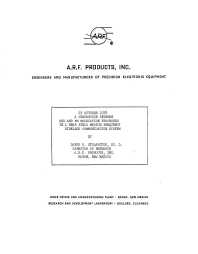Mining Publication: A Comparison Between SSB and FM Modulation Processes in a Near Field Medium Frequency Wireless Communication System
Original creation date: October 1978
This document describes the decision factors that bear on the selection of the modulation process for the wireless underground medium frequency (MF) communication system. The selected modulation process must satisfy the Bureau of Mines stated objective of improving general communications within an underground mine. The improvement being sought includes the development of a wireless communication technology of measurable benefit to both mine safety and mine productivity. The improvement will allow wireless communications paths to exist between roving miners. The wireless communication paths will also be made compatible with the existing underground telephone system to extend paging and voice communication throughout the underground mine. The new wireless equipment will include man-pack, vehicular, repeater, and base station transceivers. Repeaters and base stations will feature coupling networks for interfacing with the existing telephone circuits. Frequency modulation (FM) and single sideband (SSB) modulation processes are analyzed in view of the special conditions associated with underground mining. Of primary importance is the tremendous electrical noise generated in an operating mine that could adversely affect communications quality. High noise coupled with high attenuation rate of near field signals forces the communication system to be inherently short range. Fortunately, near field signals can propagate over great distances on underground wires and cables. The framework for comparison is generated by presenting all factors that bear on the problem. Then alternative modulation processes are considered in terms of the advantages and disadvantages of the factors as they bear on the problem. Finally, the best alternative modulation process is recommended for the wireless mine communication system.
Authors: LG Stolarczyk
Contract/MOA Report - October 1978
NIOSHTIC2 Number: 20032697
A.R.F. Products, Inc. U.S. Department of the Interior, Bureau of Mines; 1978 Oct; :1-34
See Also
- Advanced Tutorial on Wireless Communication and Electronic Tracking: Communication System Performance
- Advanced Tutorial on Wireless Communication and Electronic Tracking: Introduction
- Antenna Design & Coupling Studies at Medium Frequency for lmproved Coal Mine Communications
- Develop a Means to Model Network Performance Using Network Simulation Tools
- Magnetic Field Strength Mapping of the Helvetia Coal Co. Lucerne No. 8 Mine at Medium Frequency
- Propagation of EM Signals in Underground Mines
- Subterranean Wireless Electronic Communication System
- Transmit Antennas for Portable VLF to MF Wireless Mine Communications
- Wireless Communications and Tracking System
- Wireless Communications for Trackless Haulage Vehicles
- Page last reviewed: 10/1/2012
- Page last updated: 9/21/2012
- Content source: National Institute for Occupational Safety and Health, Mining Program


 ShareCompartir
ShareCompartir
